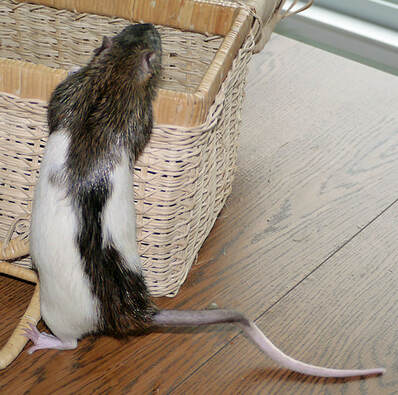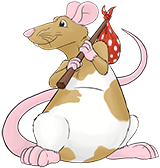“Their tails creep me out!”

The rat’s tail has a thermoregulatory function: it serves as a heat-loss organ. The tail is well suited for this purpose, because it has no fur, has a large surface to volume ratio, and is perfused with many blood vessels, especially at the tail tip and midlength (Yulong et al. 1995).
Rats control their body temperature through their tails by dilating or constricting their tail blood vessels. When the rat’s body temperature rises by a few degrees, the tail vessels (especially the veins) swell — called vasodilation — permitting lots of warm blood to flow through the tail (Vanhoutte et al. 2002). The warm blood loses heat through the surface of the tail and returns to the body at a lower temperature, thus cooling the rat. The warmer the rat, the more blood flows through the tail, and the more heat is lost (Thompson and Stevenson 1965, Little and Stoner 1968, Rand et al. 1965, Raman et al. 1987).
When the rat’s body temperature drops, the tail vessels shrink in diameter — called vasoconstriction — thus restricting blood flow to the tail (Owens et al. 2002). Less blood flows into the tail for cooling, and body heat is conserved.
BALANCE
Rats use their tails for balance. They climb ropes and anchor chains, they walk along fences and telephone wires and branches, and their tails help them balance.
The rat’s tail follows the same principle as the pole of the circus performer on a high-wire. Look at the rat balanced on the rope at right. Think of the rope as an axis, and the rat as able to rotate around that rope. The rat’s center of gravity must stay directly above the rope — if it moves to one side, gravity will cause him to start rotating around the rope. If he does not correct this rotation, he falls. The rat’s tail increases the rotational inertia of the rat, making it harder for him to rotate around the rope (specifically, it increases his resistance to change in rotational velocity). This rotational inertia gives him more time to adjust his center of gravity back to the desired position. If the rat’s tail were magically removed, his rotational inertia would disappear, his body would easily rotate around the rope and he would fall off or hang upside down by his feet. (http://www.ratbehavior.org/)
Rats control their body temperature through their tails by dilating or constricting their tail blood vessels. When the rat’s body temperature rises by a few degrees, the tail vessels (especially the veins) swell — called vasodilation — permitting lots of warm blood to flow through the tail (Vanhoutte et al. 2002). The warm blood loses heat through the surface of the tail and returns to the body at a lower temperature, thus cooling the rat. The warmer the rat, the more blood flows through the tail, and the more heat is lost (Thompson and Stevenson 1965, Little and Stoner 1968, Rand et al. 1965, Raman et al. 1987).
When the rat’s body temperature drops, the tail vessels shrink in diameter — called vasoconstriction — thus restricting blood flow to the tail (Owens et al. 2002). Less blood flows into the tail for cooling, and body heat is conserved.
BALANCE
Rats use their tails for balance. They climb ropes and anchor chains, they walk along fences and telephone wires and branches, and their tails help them balance.
The rat’s tail follows the same principle as the pole of the circus performer on a high-wire. Look at the rat balanced on the rope at right. Think of the rope as an axis, and the rat as able to rotate around that rope. The rat’s center of gravity must stay directly above the rope — if it moves to one side, gravity will cause him to start rotating around the rope. If he does not correct this rotation, he falls. The rat’s tail increases the rotational inertia of the rat, making it harder for him to rotate around the rope (specifically, it increases his resistance to change in rotational velocity). This rotational inertia gives him more time to adjust his center of gravity back to the desired position. If the rat’s tail were magically removed, his rotational inertia would disappear, his body would easily rotate around the rope and he would fall off or hang upside down by his feet. (http://www.ratbehavior.org/)
